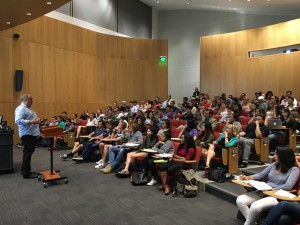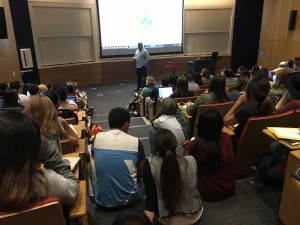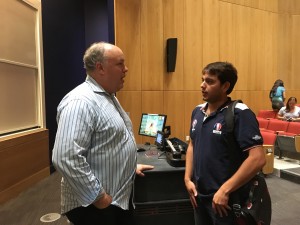How AI Will Transform Digital Marketing in 2020
On Monday, September 30th, 2019 Frank Coppersmith, CEO of Smarter Reality, a software consulting and development company located in Austin, Texas spoke as part of the Hilltop American Marketing Association’s Distinguished Marketer Speaker series on how Artificial Intelligence (AI) is transforming how firms connecting with customers. This blog post will summarize that talk which included the beginning of AI to technological advancements how it’s used in digital marketing today.
The Beginning of AI to Now
Mr. Coppersmith explained that AI first came into existence in 1956 when it was defined as the science and engineering of making machines intelligent. AI is currently defined as the simulation of human intellectual processes by machines, in particular, computer systems. Such imitated processes include the ability to learn, self-correct, and reason.
The Waves of Innovation
The AI field has undergone several evolutions and progressions over time. In fact, we are entering the sixth wave of innovation (automation, robotics, digitalization, and sustainability) in the upcoming year of 2020. Mr. Coppersmith pointed out that each of these waves, pictured below, is developing faster and are more impactful than the previous one. For example, whereas the first wave took 60 years to develop, the sixth wave is only predicted to take 25 years. The first wave was focused on water power, textiles, and commerce while the sixth wave will focus on automation, robotics, and sustainability. It’s also important to note that the pace of innovation for the sixth wave appears to be greater than the first three or four waves combined. This a testament to the exponential growth that we are witnessing today.
In the course of these developments, engineering know-how has been harnessed and utilized in AI. When put together with information communication technology and comprehensive research, machines are now able to process data with higher complexities and to undertake more sophisticated functionalities. AI application areas are developing at high-speed due to the use of big data thus setting up platforms to enable automation processes to handle a high-volume and velocity of information.
How AI is Being Innovated Today
AI technology today is replacing human cognition with machine intelligence. However, as Mr. Coppersmith puts it, “AI is only as good as the information it’s given.” He gave an example of a child using his/her parents’ Netflix account; Netflix won’t suggest the correct, age-appropriate content to the parents and won’t know that a child was making decisions on selections.
AI and AlphaGo
In information technology today, AI means implementing machine learning as an alternative to programming software. AI applications are quite literally being treated like a child who is learning and developing. Mr. Coppersmith discussed Google’s AlphaGo to illustrate machine learning. The game of Go originated in China over 3,000 years ago. Winning this profoundly complex board game requires multiple layers of strategic thinking. AlphaGo is “the first computer program to defeat a professional human Go player, the first to defeat a Go world champion, and is arguably the strongest Go player in history.” The program was taught how to play and it played against itself billions of times. Over time, AlphaGo improved and became increasingly stronger and better at learning and decision-making. This process is known as reinforcement learning (an area of machine learning).
Other Examples of AI
In addition to this simple gaming example, here are some additional areas where AI is leading the way:
- Smart robots (ex: Sophia the Robot)
- Medical diagnosis, biometrics, and treatment
- Monetary robo-advisors and hedge funds
- Global Positioning Systems (GPS) applications
- Virtual personal assistants
- Chatbots for customer service
- Facial recognition
- Product and search marketing
- Cyber defense
- Content creation
- Knowledge worker aid
What AI Means for Digital Marketing
For those in marketing, AI applications are already having an effect on how marketers do their job and will have even more impact in the future.“Simply put, AI can lift burdens, suggest actions, or just do something for you.” Here are some AI applications for common tools used in digital marketing.
Search Engine Optimization (SEO)
SEO is the practice of increasing the quantity and quality of traffic to your website through organic search engine results. AI applications can look at big data and identify trends to suggest future actions. What this means for marketers seeking to optimize how their web pages are found on search will come to rely more on machine learning. Their efforts will also become more effective as data can be analyzed via machine learning. For example, AI can enhance the accuracy of keyword research, competitor analysis, and search intent research. This newfound automation will allow marketers to devote their time and efforts elsewhere.
Email Marketing
Email marketing is the strategic use of email to connect with customers, deepen relationships, drive sales, and ascend your customers through the customer journey. The conversion rate for email marketing is the highest when an email is personal and sent at the right time. AI has the potential to design personalized emails for every customer at the right time with the right content. The time spent doing customer research could be drastically reduced with AI which would allow marketers to have a better understanding of the customer journey. Similar to personalized emails, we could start to see personalized customer journeys. Marketing could end up reaching a place where ultimate customer satisfaction is achieved.
Content Creation
On a more surface level, AI can engage in tasks like content creation. Mr. Coppersmith stated that “80% of new online content will be generated by artificial intelligence within the next 15 years.” Another example he discussed was about the international beauty chain, Sephora. They are using AI to converse with customers on their website in order to collect information about what products they like and dislike. Then, the information collected is used to generate an active content market that has the potential to spur an enormous amount of leads. Additionally, AI is currently being used to deploy chatbots, customize news feed algorithms, and predict what the customer will want to read now and in the future.
What’s the Risk of AI?
In the future, it is possible that AI could produce another form of AI without us even knowing. The fear is that AI will conflict with itself and that would be a completely new challenge. “This can be a great thing or an extremely negative thing like the Boeing 747 software that conflicted with itself and caused a loss of human life.
In summary, while AI in marketing is powerful, we are just now about to enter the sixth wave of innovation in 2020. The industry has only begun to see how AI can be implemented. As marketers, we have to ensure that our use of AI is both ethical and sustainable.








